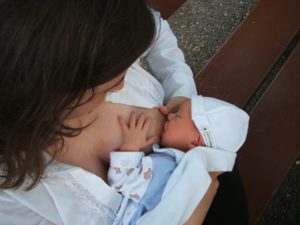It takes time for your body to recover from the birth and you may wonder how you can look after yourself when you need to spend so much time looking after your baby.
Some tips that may help:
- Ask for help from supportive people you trust (e.g. your partner, family, friends and health care provider).
- Say no to household tasks and other chores that aren’t urgent.
- Take a nap when your baby naps.
- Taking a bath or shower can help you feel relaxed and refreshed.
- Don’t use alcohol, tobacco or drugs. Limit caffeine.
- Take time for yourself. Even a short break can help you feel refreshed
- Eat well, get plenty of fluids and do some gentle physical activity e.g. walking.

Caring for Physical Changes
Normal Bleeding (Lochia):
You will have a discharge or flow (lochia) from your vagina after your baby is born which may last up to 6 weeks. This flow will happen regardless if you gave birth vaginally or by caesarean.
- For the first 1–3 days, there is a heavy flow of bright, then dark red blood. You may need to change your pad every 1–3 hours and its common to also pass a few small clots (no bigger than 2 cm), or no clots at all.
- During days 4–10 after giving birth, the flow will likely be brownish or pink and starts to decrease each day. You’ll need to change your pad every 3–5 hours.
- After 10 days, the flow usually has become yellowish white.
It’s normal for your flow to be heavier during and after breast/chestfeeding, after activity, and after sitting or lying down for a while. If the flow gets a lot heavier after activity, it may be a sign that you’re doing too much and need to rest more.
Contact your health care provider immediately if:
- You pass a clot larger than 2 cm and have heavy blood flow (soaking 1 pad in less than 1 hour in the first 3 days, or soaking 1 pad in less than 3 hours on day 3 or more)
- Your flow is not getting lighter
- Your flow goes back to bright or dark red and you are bleeding heavily after it has changed to brownish/pink or yellowish white
- You have pain in your abdomen (sharp and stabbing)
- You have a fever over 38°C with chills or aches, or if you have a fever over 30°C without chills or aches for more than 2 days
- If the flow smells bad
Call 911 or go to emergency: if you have heavy, rapid (or steady) vaginal flow of very large amounts of blood. The blood may overflow your pad, run down your leg or form a large pool.
Perineal Care:
The perineum may be very sore for the first few days after a vaginal birth. If you have an incision from an episiotomy it may take up to 2–4 weeks to heal. If you have any stitches they will dissolve on their own and it is common to find small pieces of the stitches on your pad as your body heals.
Some tips that can help with perineal care:
- Wet an open sanitary pad with water and freeze it. Put the frozen pad on the perineum for 20 minutes intervals, several times a day during the first 24 – 48 hours or more after birth.
- After the first 48 hours, warmth rather than ice may help. Try taking a warm bath or use a sitz bath (a bowl that sits over the toilet, available from pharmacies) .
- Lie on your side, rather than sitting, when you rest, sleep or breast/chestfeed.
- Take pain medicine as recommended by your health care provider. This may help you feel more comfortable when sitting. If you’re breast/chestfeeding, only a small amount of this medicine will pass to your baby through your milk and is safe for your baby if taken as directed.
- Rest if your flow increases.
- After going to the bathroom, pour warm tap water over your perineum from a squeeze bottle.
- Gently dry your perineum with toilet paper, patting dry from front to back.
- Change your pad each time you go to the bathroom, or at least 5 times a day.
- Don’t touch the surface of your pads. This will keep them as clean as possible.
- Wash your hands before and after changing your pad and any time you go to the bathroom.
- To help prevent infection, don’t use tampons for the first 6 weeks after having your baby.
Call your healthcare provider if, instead of feeling better, you have increased soreness in your perineum.
Breast and Nipple Care:
A few days days after the birth, breast tissue swells and your body starts making more milk. The swelling will go away over time. Your breasts will keep making as much milk as your baby needs, even after your breasts begin to feel softer.
When breast/chestfeeding:
- Wear a cotton nursing bra that doesn’t have underwire.
- Massage your breasts to empty the ducts while feeding.
- Use cotton pads or disposable pads that don’t have a plastic lining in your nursing bra.
- If your breasts become uncomfortable, take a warm shower or bath or place warm wet washcloths on your breasts just before you feed your baby. This will help your breasts to leak or make it easier for you to express some milk until you’re more comfortable.
- Put warm compresses (e.g. warm wet washcloths) on your breasts before feedings, and cool compresses (e.g. gel packs, frozen peas) after feedings to help with tenderness.
- Try not to use soap on your nipples. This dries them out.
- If you have nipple jewelry, take it out before feeding.
- If your nipples feel sore, try changing your feeding position and get help to make sure your baby is latching on correctly.

Contact your health care provider immediately if your breasts become hard, red and painful and if you have a fever (over 38°C) with chills, or if you have a fever over 38°C for more than 2 days.
After pains:
After the birth, the uterus contracts as it returns to its pre-pregnant size. These after pains may feel like menstrual cramps and are often stronger for people who have given birth more than once. It is normal for after pains to feel stronger when you are breast/chestfeeding, and breast/chestfeeding can help the uterus recover faster. After pains should start to lessen after 3–5 days.
To help with the discomfort of after pains:
- Use a warm water bottle on your abdomen for comfort.
- Take pain medicine as recommended by your health care provider. If you’re breast/chestfeeding, only a very small amount of this medicine will pass to your baby.
Contact your health care provider immediately if nothing seems to lessen your pain. Or your pain feels worse or is bad and/or your abdomen is tender to touch.
Bowel Movements and Hemorrhoids:
You may find it is a couple of days before you have a bowel movement after the birth. Constipation is common. To prevent constipation:
- Drink plenty of fluids.
- Eat plenty of vegetables, fruit and whole grains.
- Be physically active.
- Try natural laxatives (e.g. prunes, figs and bran).
- Take a stool softener, if recommended by your health care provider.
Hemorrhoids are enlarged blood vessels inside and/or outside the rectum that can be caused by hormone changes and birthing your baby. Hemorrhoids usually shrink and become less painful over time. To relieve the discomfort from hemorrhoids:
- Put ice packs (or a frozen sanitary pad) on your anal area for 20 minutes every 4 hours for the first 4 days after giving birth.
- Use warm water in a squeeze bottle to clean your anal area after having a bowel movement.
- Lie on your side whenever possible and avoid standing for too long.
- Use good positioning on the toilet so you don’t strain: keep your back straight and put a small stool under your feet to raise your knees higher than your hips.
- Use medicated pads or hemorrhoid cream.
- Take pain medicine as recommended by your health care provider.
- Sit on a soft pillow for more comfort.
- Drink plenty of fluids and eat plenty of vegetables, fruit and whole grains.

Contact your health care provider immediately if:
- you feel you need to have a bowel movement, but you can’t.
- your bowel movements are painful and hard.
- you haven’t had a bowel movement 3 days after your baby’s birth, nothing seems to help and you are in pain.
- You feel your hemorrhoids are preventing you from having a bowel movement
- Your hemorrhoids are very painful and hard
- You are bleeding from your rectum (different from vaginal bleeding)
Swollen Ankles and Feet:
After the birth, extra fluid can collect in your feet and ankles. To help relieve the discomfort:
- Put your feet up as often as possible and avoid standing for long periods of time.
- Wear loose clothing and avoid socks and tight fitting shoes.
- Don’t cross your legs when sitting.
Contact your health care provider immediately if:
- One foot, ankle or calf is more swollen than the other
- The swelling gets worse
- You have a red, painful and/or hot lump in your lower leg
After a Caesarean Birth
- Take it easy: During recovery, avoid housework and lifting anything heavier than the baby. Do not lift the baby in the car seat. If possible, have everything on the same level of the house to avoid going up and down stairs continuously.
- Support the abdomen: Use good posture when standing and walking. It can help to hold the abdomen near the incision during sudden movements caused by coughing, sneezing or laughing and hold a pillow to the abdomen when standing up or moving in bed. When getting up from lying down, first roll onto the side and then push up to a sitting position.
- Limit company for the first few weeks: Too many visitors will keep you from getting the rest you need to recover and care for your newborn. Accept helpers, people who will make meals, do laundry and tidy the home.
- Rest: It can help recovery to take daily naps for the first 3 to 4 weeks or longer.
- Stay hydrated: You will likely need extra fluids to replace those lost in delivery and breast/chestfeeding. Emptying the bladder frequently can help reduce the risk of urinary tract infections.
- Avoid driving: Until you are able to deal with making sudden movements when driving in traffic, you should avoid driving. This could take up to 6 weeks. Your car insurance provider may also have restrictions with how coverage may be affected by surgery.
- Keep the incision clean: Shower every day after the first 24-48 hours to keep the incision clean, unless your healthcare provider says otherwise. When cleaning and drying avoid scrubbing the incision site as this may pull on the staples or stitches, instead pat dry with a towel when done. Showering rather than taking a bath is recommended until the incision is completely healed.
Emotions after a caesarean birth vary widely. Some new parents feel relief when it’s all over, yet may also feel a little disappointed. If you are upset or worried, talk with your healthcare provider, partner, or someone you trust.
Many people who have a caesarean birth can have a vaginal birth with a later pregnancy (VBAC). This can be discussed with a health care provider before or during the next pregnancy.
Contact your health care provider immediately if:
- there is increased oozing or blood coming from the incision
- there is yellow or green discharge coming from the incision
- the pain gets worse, or isn’t helped by the pain medicine
- the incision is opening up
- there are red, hot and tender areas around the incision
- there is a fever of more than 38 ºC
- the legs have red, hot patches on them